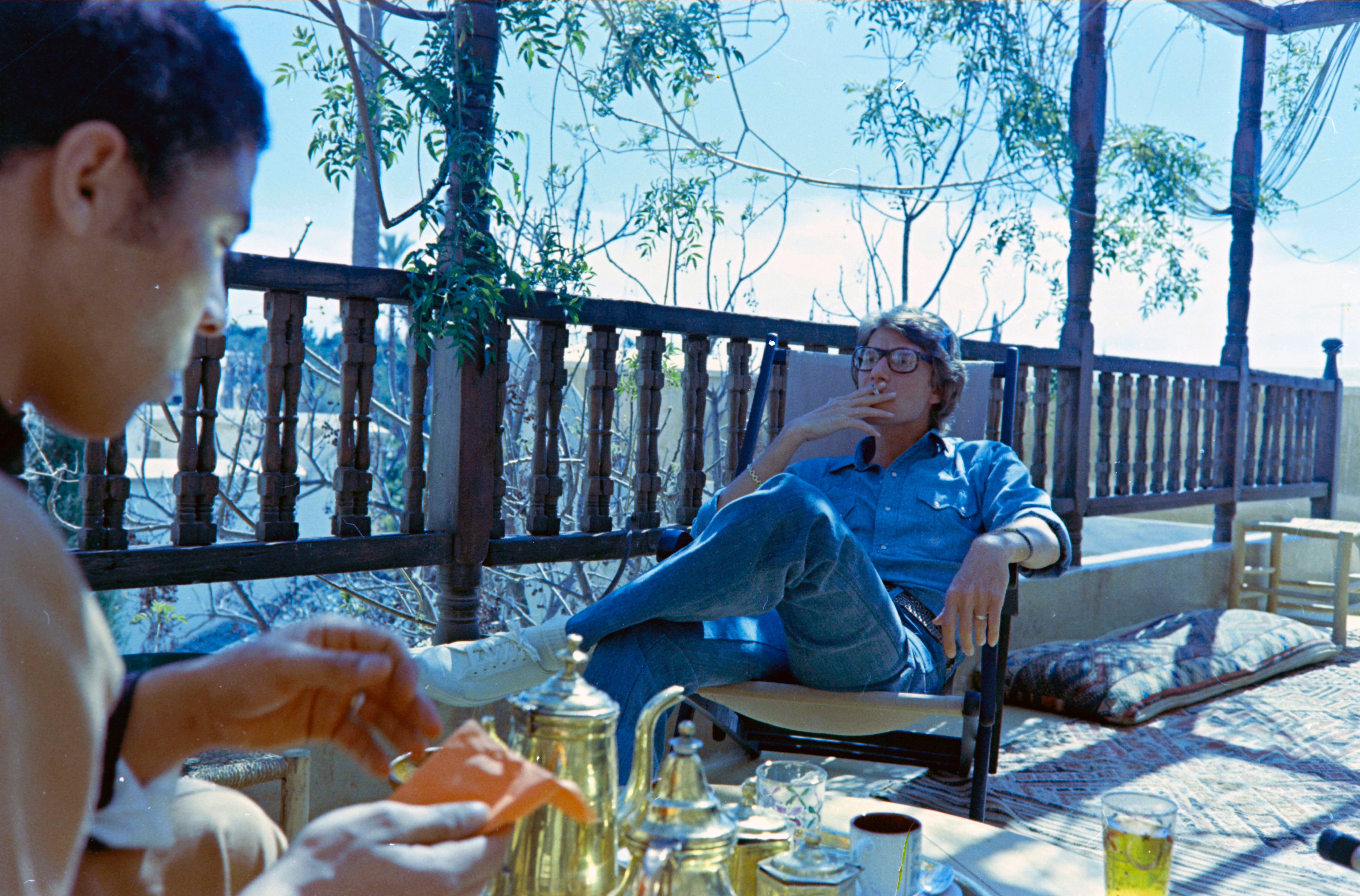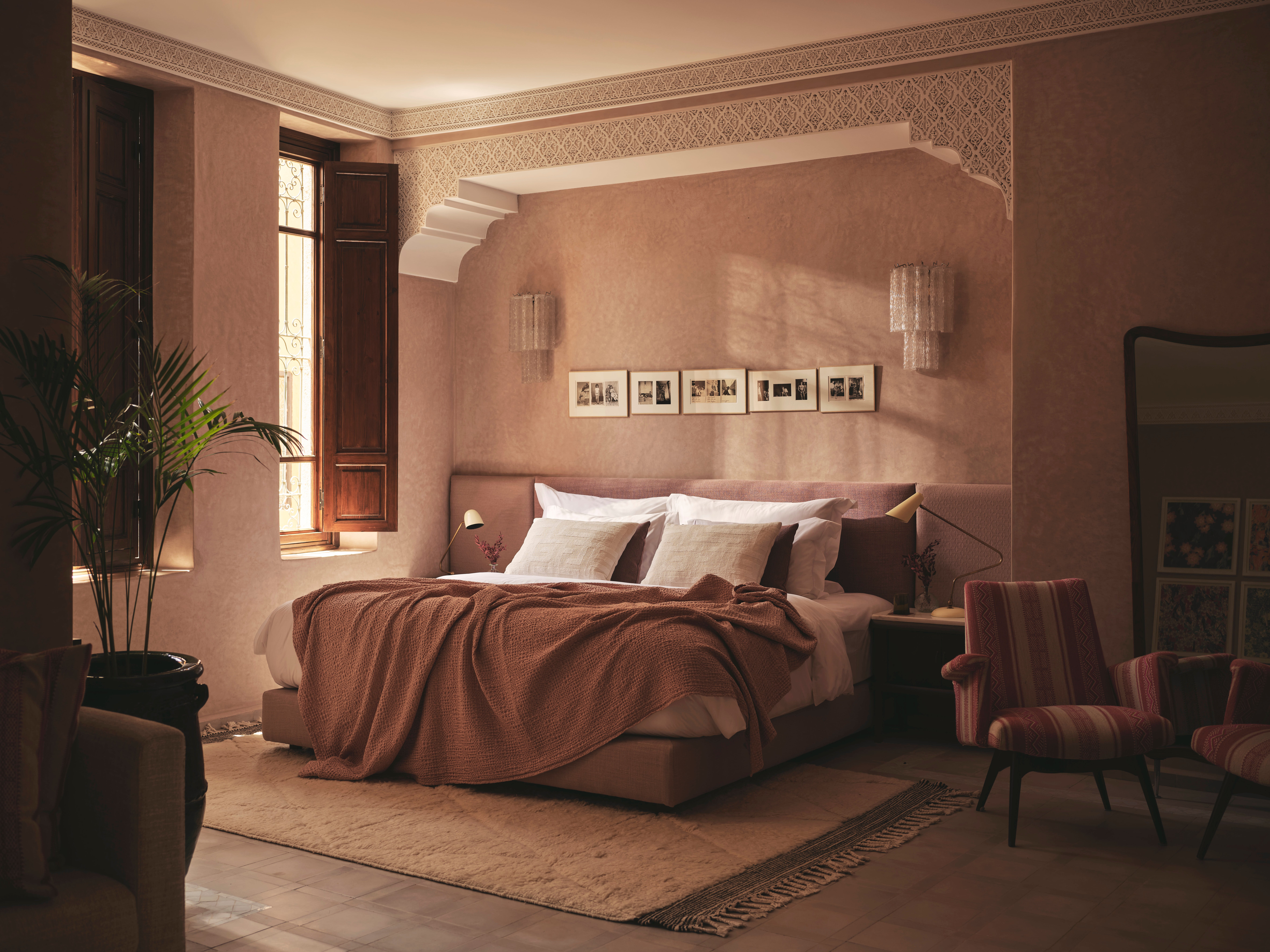The Independent's journalism is supported by our readers. When you purchase through links on our site, we may earn commission.
The hedonistic, boho-luxe of 1970s Marrakech is back – here’s how to do it like Mick Jagger and Grace Jones
Grace Jones, Yves Saint Laurent, Jack Kerouac and Jagger – all discovered a world of colour and hedonism in 20th-century Morocco. And now today’s visitors can too, thanks to a riad hotel that’s steeped in history and lined with the legacy of socialite Bill Willis, finds Jessica Rawnsley

In Marrakech’s dusk-hued medina, there’s a riad that opens a door to another world. The gilded home of the late interior designer and febrile socialite, Bill Willis, Dar Noujoum was once a royal residence, rented to Willis by a prince from the early 1970s until his death in 2009. Stood empty in the ensuing years, it was summarily ransacked – doors stripped of their hand-carved frames, copper piping wrenched from walls, baths hoisted out of windows to the street below. A decade later, Brits and best friends Tim and Neil would discover the riad and, with it, a slice of history.
Exploring the crumbling palace, as Neil hollered for Tim to join him on the roof – the highest in the medina, offering mountain-bound views of the Red City – Tim stumbled upon something astonishing. Two tattered cream suitcases, plastered in travel stickers, overflowing with letters, photographs, sketches.
“I realised we’d stumbled onto a time capsule from that era and the heyday of Marrakech,” he recalls. “I was blown away. It’s the closest that me or anybody I know will ever come to discovering a treasure trove. Actual treasure. I couldn’t believe they had taken everything else and left the best things.”

Among the school reports, holiday snaps and cantankerous letters from jilted ex-lovers were notes from the glitterati of rock ‘n’ roll Marrakech – Grace Jones, Mick Jagger, Yves Saint Laurent – praising Willis’s hosting skills, telling him to drop in when he came to London, berating his profligate spending and reiterating that no, he could not have an advance.
Read more on Morocco travel:
For four decades Willis was the epicentre of the storm in Marrakech – voluptuous houses, extravagant parties, fractious love affairs, opium-hazed dreams, indolent luxury. First visiting in 1968 while accompanying John Paul Getty and his wife Talitha on their honeymoon, Willis fell fast – and soon brought the beau monde with him. By all accounts, he was a dissolute genius, with a yawning appetite for grand things, irrepressible flair, and a perennially over-drawn purse.

His reinterpretation of traditional Moroccan artistry with modern twists and colour palettes sent ripples through Marrakech and the wider architectural world – sparking the trend of Seventies and Eighties bohemian socialites flocking to restore rundown riads and revel in the city’s shades.
He built lavish, intricately adorned homes for the likes of the Rothschilds, Agnellis and Gettys (the latter’s nicknamed the “pleasure palace”). He brought sidelined techniques to the fore – taking tadelakt (smooth wall finish) from hammams into houses and eye-bending zellij-embellished fireplaces into riads. Not a crevice or corner was spared his flourish. As Pierre Bergé once put it: “It was Bill who coined the design vocabulary of today’s Morocco. Even if he was from the South and drank too much bourbon, he was not American. He struck America from his life.”

The tangible remnants of Willis’s legacy now line the walls of IZZA, a 14-room boutique hotel comprising seven interlocking riads, with strings of courtyards encircled by emerald-tiled pools, a vine-draped rooftop restaurant and a curated library stacked with art books and novels.
IZZA, a few streets away from Dar Noujoum, was originally intended as a holiday home, but with Willis whirring in the back of their minds the project spiralled, one riad becoming seven, art its raison d’etre. It is, in part, an ode to Willis and his august friends. His design flourishes can be seen throughout, in the delicate friezes of white plasterwork above beds or the bands of mosaic zellige laid into staircases. Each room is named after a member of the ‘freedom seekers’ of the Sixties, Seventies and Eighties: Yves Saint Laurent, Talitha Getty, Cecil Beaton, Jack Kerouac, Mick Jagger.
It was as close to stepping back in time as we could get; we were in the shadows of something that had gone on before
It took eight years to build, employing dozens of local artisans and drawing on the country’s omnipresent artistry, from sourcing golden lamps in the medina to hand-woven rugs crafted by women in the Atlas mountains. The attention to detail is herculean: a headboard in one of the rooms, for instance, took two artisans two weeks to hand-carve, sculpt and paint. The space is flush with vintage furniture, hand-picked and scrupulously placed: delicate chandeliers paired with 1950s oak loungers. Every item has a story to tell. I stayed in Yves’ room, a palatial, dusk-hued suite with a plush, expansive bed, ceramic bath, and mahogany cupboards replete with YSL books and love letters from Bergé.
One evening, we donned hardhats and clambered up candle-lit staircases to the rooftop of Dar Noujoum to watch the setting sun spread its colours across the sky. Up in the ether, the medina sprawled in every direction, soaked in golden light, and beneath was a graveyard, white gravestones jutting up from the red dust like teeth. Local musicians warbled and strummed sitars. For a moment, worlds collided; we were standing where those before had stood, absorbing the sights and sounds that sparked their curiosity and artistry.

“My hair stood up on end there,” says Tim, “because I knew that nobody had been there since whenever Bill last had a gathering. So that was a real moment. It was as close to stepping back in time as we could get; we were in the shadows of something that had gone on before.”
Once Dar Noujoum is restored to its former glory, it will be transformed into an artists residency, a Bill Willis charitable foundation to not only burnish and continue his legacy but commemorate Morocco’s rich history and lift up the artists of today.
IZZA, likewise, is conceived as a “living, breathing” space – an attempt to evoke the city’s artistic past while celebrating its present. It is flush with artworks, both contemporary and international, historic and local. NFTs to the tune of £5m wink from secluded corners, including the striking Ethiopian Yatreda collection. Leila Alaoui’s Les Marocains line the walls of the stylish reception. Sebastião Salgado’s striking photographs populate the roof terrace.
If we don’t grab the story now, it’s a chapter in time that could be lost forever
Some of the young Moroccan artists on display include observational photographer Anass Ouziz, who captures ephemeral moments across his country; Mouhcine Rahaoui, a multi-disciplinary artist whose bold work uses coal and wax to render the experiences of miners in his hometown Jerrada; and Khadija Jayi, whose language is striking swirls of fire. Partnerships with local artists such as these aim to foster opportunities through a residency programme and artists talks to bring together local and visiting artists and industry leaders.
And the Morocco that captured hearts and minds is ever-present. Preserved in the sonorous tones of the nightly call to prayer ringing out across the twinkling city; the ceremonial pouring of tea from curved, silver teapots; the calls of the snake charmers in Jemaa el-Fnaa square; the bright piles of spices and hand-woven rugs unfurled with a flourish. Part of the Red City’s enduring appeal is its evocation of the past, even as motorbikes zip through narrow lanes and music blares from mobile phones.
“Before Marrakech, everything was black,” Yves once said. “This city taught me colour, and I embraced its light, its insolent mixes and ardent inventions. It was when I discovered Morocco that I realised my own chromatism was that of Moroccan caftans, zelliges, zouacs and jellabas. The boldness seen since then in my work, I owe to this country, to its forceful harmonies, to its audacious combinations, to the fervour of its creativity.”

Visitors to the city can trace that ardour on a visit to the Majorelle Garden, a botanical paradise cultivated by Yves and Pierre with vivid splashes of blue and yellow and over 300 exotic plant species, or peruse the Yves Saint Laurent museum – or simply wander the 1,000-year-old sandstone medina.
Relatively unknown outside his gilded circles, Bill’s legacy is being lovingly commemorated and perpetuated by the owners of IZZA. “We feel that if we don’t grab the story now, it’s a chapter in time that could be lost forever,” Tim explains. “It is an amazing privilege to create this foundation to restore his home to what it once was, and then open it up and breathe life back into that again.”
Travel essentials
Getting there
Royal Air Maroc, British Airways, easyJet and Ryanair all run regular flights to Marrakech from across the UK; prices vary by season but can be anywhere from £20-£200.
Staying there
Rooms at IZZA start at £138, B&B (including transfers and hammam), up to the Yves Saint Laurent suite for £429, B&B.
Read more of our best Marrakech hotel reviews






Join our commenting forum
Join thought-provoking conversations, follow other Independent readers and see their replies
Comments